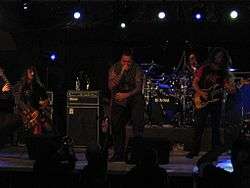Sadist
Sadist refers to:
Sadist may also refer to:
Sexual practices
Music
- Sadist (album), their self-titled album
See also

Sadist (band)
Sadist is a death metal band from Genoa, Italy, founded in 1991. The band split up in 2000 after releasing their Lego album, but reunited in 2005 and released their self-titled album in 2007.
History
Sadist was formed in 1991 when Tommy (guitar, keyboards) and Peso (Necrodeath - drums) started auditioning for musicians to complete their lineup. A few weeks after, the auditions, Andy (bass) and Fabio (vocals) joined. While playing locally with original content from their demo, they caught the attention of the indie label Obscure Plasma Records. Their demo was released as Black Screams EP in September 1991, and sold 2500 copies worldwide. The EP was later released in 1992 by American indie label Wild Rag Records in a three-track version. The band toured Italy and France until Fabio left the band, which forced Andy to play bass as well as sing.
Shortly afterward, the band plays a show in Lisbon and were well received by audience and local media. The band then obtains a record deal with Nosferatu Records for a two-album contract and releases Above the Light in 1993. Then, Andy leaves the band, and is replaced by bassist Chicco and a new singer, Zanna. In late 1993, the band records a video for the song "Sometimes They Come Back" from the Above the Light album and tour France and the Netherlands.

Sadist (album)
Sadist is the eponymous fifth full-length studio album by the Italian progressive death metal band Sadist, released on April 17, 2007 by Beyond Productions. This release marks Sadist's return not repeating styles from their last release but taking their musical styles back to the "Tribe era".
Track listing
Credits
Elysia
Elysia may signify:

Elysia (gastropod)
Elysia is a genus of sea slugs, marine gastropod molluscs in the family Plakobranchidae. These animals are colorful sea slugs, and they can superficially resemble nudibranchs, but are not very closely related to them. Instead they are sacoglossans, commonly known as sap-sucking slugs.
Elysia sea slugs graze on algae and some species such as E. viridis and E. chlorotica hijack the chloroplasts for themselves. The chloroplasts end up lining the slug’s digestive tract, enabling the slugs to survive solely by photosynthesis for several months at a time. This association is crucial for the development and maturing of the slug. Exactly how the slugs use the chloroplasts is unclear, as many of the proteins used are encoded in the genome of the host cell. These proteins, numbering in the hundreds, are manufactured in the cell’s nucleus, and then moved into the chloroplast, enabling it to survive.
This genus was previously sometimes considered to be in the family Stiligeridae, and was also previously placed in the family Elysiiidae.

Aniliidae
The Aniliidae are a monotypic family created for the monotypic genus Anilius that contains the single species A. scytale. Common names include American pipe snake and false coral snake. It is found in South America. This snake possesses a vestigial pelvic girdle that is visible as a pair of cloacal spurs. It is ovoviviparous. Its diet consists mainly of amphibians and other reptiles. Currently, two subspecies are recognized, including the typical form described here.
Description
This species is found in Amazonian South America, the Guianas, and Trinidad and Tobago. It is a moderate-sized snake attaining a size of about 70 cm (28 in) in length. It is reported to be ovoviviparous and feeds on beetles, caecilians (burrowing amphibians), amphisbaenids (legless lizards), small fossorial snakes, fish, and frogs. It has a cylindrical body of uniform diameter and a very short tail; it is brightly banded in red and black (but without yellow bands); reduced eyes lie beneath large head scales. It is considered to be the snake that most resembles the original and ancestral snake condition, such as a lizard-like skull.
Podcasts:

